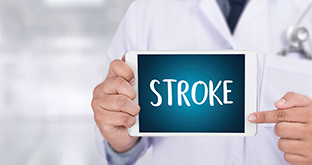Stroke is a significant and often sudden health concern you should know how to recognize. According to the American Stroke Association, there are nearly 800,000 cases of stroke in the United States each year, and stroke is the fifth leading cause of death here.
The American Stroke Association and other health organizations observe National Stroke Awareness Month in May and World Stroke Day in October to bring public awareness to stroke. Do you know how to recognize the warning signs of strokes? Many Americans don’t. Stroke is always a medical emergency, so learning how to spot a stroke is crucial.
Recognize the Signs of Stroke
The best way to remember common stroke warning signs is to think of the acronym “Be Fast,” which was developed by Intermountain Healthcare. *Be Fast stands for:
B = BALANCE: Has the person suddenly lost balance or coordination?
E = EYES: Has the person suddenly experienced changes in vision?
F = FACE: Does the person’s face look uneven, or does one side droop?
A = ARMS: Has one arm gone weak or numb?
S = SPEECH: Does the person’s speech sound slurred or strange?
T = TIME: If you observe any of these signs, it’s time to call 9-1-1 or get to the nearest stroke center or hospital emergency room for rapid diagnosis and treatment. Other signs of stroke include numbness on one side of the body, trouble seeing with both eyes, trouble walking, and sudden onset of a severe headache.
Lower Your Risk of Stroke
Stroke impacts certain groups more than others so there’s not much you can do about some risk factors. More women than men have strokes, and African Americans are more at risk for stroke. Also, if you have a family history of stroke, you have an increased risk.
The American Stroke Association says high blood pressure is the leading cause of stroke. Other risk factors include cigarette smoking, diabetes, poor diet, physical inactivity, and obesity. Alcohol and drug abuse can also increase stroke risk.
You can make changes to your lifestyle to reduce your risk. Eating a healthy diet rich in vegetables and limiting saturated fats and trans fats can improve your overall health and help reduce your risk of chronic diseases. Exercising five or more times per week has been shown to reduce stroke risk. If you smoke, stop. Smoking doubles your risk of having a stroke.
How is Stroke Treated?
Shahid Rafiq, MD, a stroke specialist neurologist and the medical director of neurology and stroke for Holy Cross Health, says treating stroke starts immediately with attending to the patient and evaluating them for treatment. Treatment options include intravenous medication, mechanical extraction, or intra-arterial medication.
Dr. Rafiq is passionate about taking care of the patient’s emotional state. “I am trained in dealing with the complex medical problems,” he says. “But I never lose sight of the emotional trauma that the patient and the families are having. It’s my personal philosophy to explain to them in very simple terms what is going on with the patient, what is their disease, what is our plan, and how we are going to address it.”
Watch Dr. Rafiq talk more about treating stroke with the latest technology:
Learn More About Stroke Care at Holy Cross Health
When a stroke occurs, our medical team provides top-quality care. Holy Cross Health's two hospitals, Holy Cross Germantown Hospital in Germantown, Md., and Holy Cross Hospital in Silver Spring, Md., are designated as Primary Stroke Centers, delivering top-quality stroke care, by The Joint Commission and by the Maryland Institute for Emergency Medical Services Systems.
The American Stroke Association has awarded Holy Cross Hospital and Holy Cross Germantown Hospital the 2020 Get with the Guidelines® – Stroke Gold Plus Achievement Award, along with the 2020 Target: Stroke Honor Roll Elite Award for Holy Cross Hospital, Target: Stroke Elite Award for Holy Cross Germantown Hospital.

